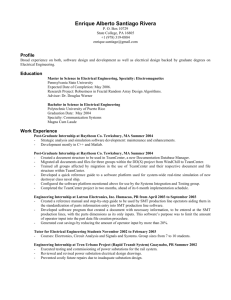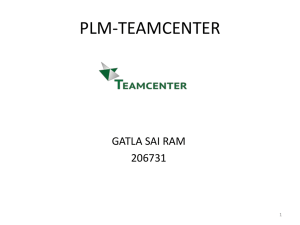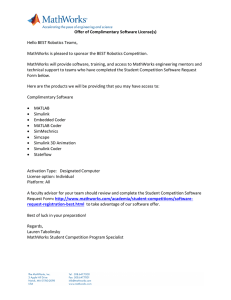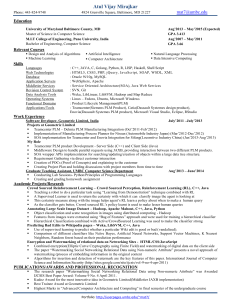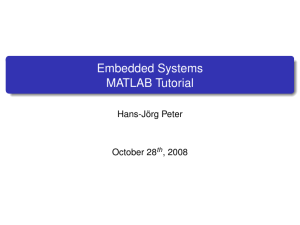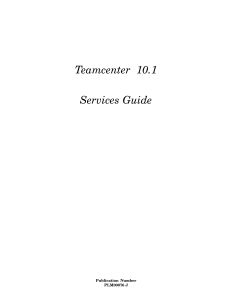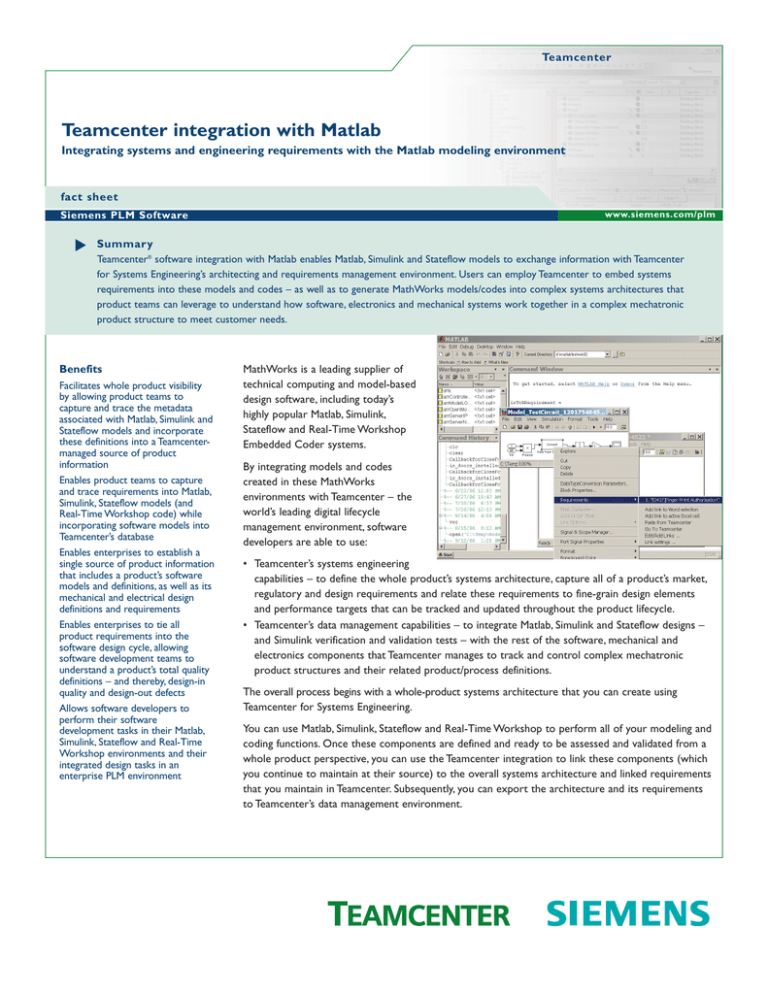
Teamcenter
Teamcenter integration with Matlab
Integrating systems and engineering requirements with the Matlab modeling environment
fact sheet
www.siemens.com/plm
Siemens PLM Software
Summary
Teamcenter® software integration with Matlab enables Matlab, Simulink and Stateflow models to exchange information with Teamcenter
for Systems Engineering’s architecting and requirements management environment. Users can employ Teamcenter to embed systems
requirements into these models and codes – as well as to generate MathWorks models/codes into complex systems architectures that
product teams can leverage to understand how software, electronics and mechanical systems work together in a complex mechatronic
product structure to meet customer needs.
Benefits
Facilitates whole product visibility
by allowing product teams to
capture and trace the metadata
associated with Matlab, Simulink and
Stateflow models and incorporate
these definitions into a Teamcentermanaged source of product
information
Enables product teams to capture
and trace requirements into Matlab,
Simulink, Stateflow models (and
Real-Time Workshop code) while
incorporating software models into
Teamcenter’s database
Enables enterprises to establish a
single source of product information
that includes a product’s software
models and definitions, as well as its
mechanical and electrical design
definitions and requirements
Enables enterprises to tie all
product requirements into the
software design cycle, allowing
software development teams to
understand a product’s total quality
definitions – and thereby, design-in
quality and design-out defects
Allows software developers to
perform their software
development tasks in their Matlab,
Simulink, Stateflow and Real-Time
Workshop environments and their
integrated design tasks in an
enterprise PLM environment
MathWorks is a leading supplier of
technical computing and model-based
design software, including today’s
highly popular Matlab, Simulink,
Stateflow and Real-Time Workshop
Embedded Coder systems.
By integrating models and codes
created in these MathWorks
environments with Teamcenter – the
world’s leading digital lifecycle
management environment, software
developers are able to use:
• Teamcenter’s systems engineering
capabilities – to define the whole product’s systems architecture, capture all of a product’s market,
regulatory and design requirements and relate these requirements to fine-grain design elements
and performance targets that can be tracked and updated throughout the product lifecycle.
• Teamcenter’s data management capabilities – to integrate Matlab, Simulink and Stateflow designs –
and Simulink verification and validation tests – with the rest of the software, mechanical and
electronics components that Teamcenter manages to track and control complex mechatronic
product structures and their related product/process definitions.
The overall process begins with a whole-product systems architecture that you can create using
Teamcenter for Systems Engineering.
You can use Matlab, Simulink, Stateflow and Real-Time Workshop to perform all of your modeling and
coding functions. Once these components are defined and ready to be assessed and validated from a
whole product perspective, you can use the Teamcenter integration to link these components (which
you continue to maintain at their source) to the overall systems architecture and linked requirements
that you maintain in Teamcenter. Subsequently, you can export the architecture and its requirements
to Teamcenter’s data management environment.
Teamcenter
fact sheet
Benefits continued
Enables cross-discipline teams to
participate in an integrated design
environment that accounts for the
entire product configuration as it
evolves across all of its lifecycle
states
Allows enterprises to incorporate
software development processes
within their global product
development cycle, including
processes that require change
management, software problem
reporting and release level tracking
Enables enterprises to accelerate
their product lifecycle, improve its
quality and reduce its cost by
allowing product development
teams to understand the impact of
software design as early in the
product lifecycle as possible
Features
Data integrity ensured by vaulting
Matlab, Simulink, Stateflow and RealTime Workshop metadata in
Teamcenter while retaining bulk of
theses models/codes at their source
Automatic data exchange between
the MathWorks applications and
Teamcenter initiated by ad hoc user
queries, as well as demand-driven
and event-driven data requests
Dynamic part support (ability to
link Matlab, Simulink and Stateflow
files to Teamcenter parts, thereby
ensuring that every part query
retrieves its related software
component)
Automatic synchronization between
Matlab/Simulink/Stateflow and
Teamcenter to ensure that changes
to a software model results in
changes to its related Teamcenter
metadata (and vice versa)
Dynamic version support
Ability to integrate Matlab, Simulink
and Stateflow software components
into Teamcenter’s standards-based
change process
Ability to integrate Matlab, Simulink
and Stateflow software components
into Teamcenter-managed product
configurations that facilitate
derivative and variant management
In essence, the Teamcenter integration captures your MathWorks models and connects them into an
overall systems architecture that you manage in Teamcenter.
After the MathWorks models are captured in Teamcenter, any changes to the Matlab, Simulink or
Stateflow model automatically result in updates to the Teamcenter database – and vice versa. In essence,
this establishes a “living” integrated model of the system with its software. At any time, you can use
Real-Time Workshop to generate ANSI/ISO C code for the embedded target operating system.
Teamcenter enables you to establish high-level product configurations that identify all bill of material
(BOM) views and underlying design elements that comprise a product. The end result is a complex
product configuration that defines your product in terms of its software, mechanical and electrical
design elements and their interactions – which has never been possible before.
Use case
Teamcenter enables you to establish an interdisciplinary environment for facilitating systems engineering
with web-based groupware, collaboration and information-linking capabilities that your product teams
can use to:
• Model a product and its related processes into high-level hierarchies. Typically, systems engineers use
Teamcenter’s Systems Architect and its graphical building blocks to create/capture a systems
architecture that represents a product and its processes from multiple perspectives, including highlevel product structures, program-related organizational assignments, supplier relationships, manufacturing process views, project management perspectives, cost analyses and documentation views.
• Provide whole product visibility. Once the product and its processes are captured, systems engineers can
use Systems Architect’s linking capabilities to interrelate these views together to provide a whole
product perspective that planning, project management, development and manufacturing teams can
leverage for cross-discipline optimization.
• Leverage linked product requirements. Teamcenter’s Requirements Management solution enables
product teams to capture requirements documents from multiple sources, parse these documents
for individual requirements and allocate these requirements to fine-grain design elements within a
Teamcenter-managed product configuration.
• Establish quantitative program constraints. Product teams also can leverage Teamcenter’s Requirements
Management solution to link the product’s system-level hierarchies to quantitative program/project
constraints. These constraints define metrics that can be tracked and reported across the
development cycle.
• Manage product development. You can use Teamcenter to establish controls over such business factors
as cost, resource allocations, work functions, system functions and scheduling limits – as well as
engineering controls over such factors as performance, reliability, throughput, material/substance
restrictions and many other considerations. Most importantly, connected constraints enable product
teams to understand the interdependent relationships that exist between different aspects of the
product and how these relationships impact one another.
Contact
Siemens PLM Software
Americas
800 498 5351
Europe
44 (0) 1276 702000
Asia-Pacific 852 2230 3333
www.siemens.com/plm
© 2008 Siemens Product Lifecycle Management Software Inc. All rights reserved. Siemens and the Siemens logo are registered trademarks of Siemens AG.
Teamcenter, NX, Solid Edge,Tecnomatix, Parasolid, Femap, I-deas, JT, UGS Velocity Series and Geolus are trademarks or registered trademarks of Siemens Product
Lifecycle Management Software Inc. or its subsidiaries in the United States and in other countries.All other logos, trademarks, registered trademarks or service
marks used herein are the property of their respective holders. 1/08

